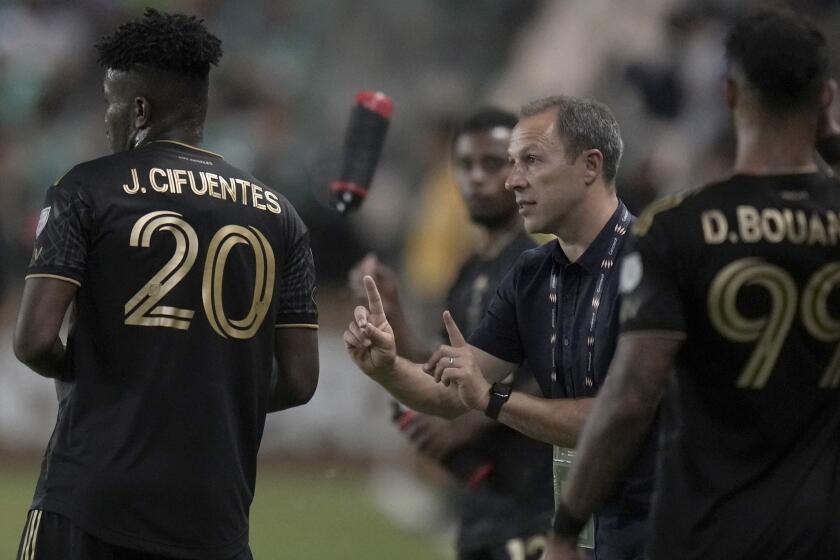League reaches milestone moment
- Share via
Women’s Professional Soccer has survived its first season, and if that fact brings a sigh of relief from league officials going into Saturday’s championship game in Carson, it is only natural.
“You really can’t overestimate what a huge task this is in the first season for any sports league,” said Tonya Antonucci, WPS commissioner.
Nearly five months have passed since the Los Angeles Sol defeated the Washington Freedom at the Home Depot Center in the league’s inaugural game.
Seventy-two games have been played since then, and the first WPS season will culminate with Saturday’s 1 p.m. final between the regular-season champion Sol and New Jersey’s Sky Blue FC, which defeated St. Louis Athletica, 1-0, in Wednesday night’s semifinal in St. Louis.
In between, many lessons have been learned. None of the seven WPS teams made a profit in 2009. “There are some teams that are losing in the $1-million to $2-million range,” Antonucci said.
WPS attendance has been unexceptional, with average attendance of 4,493, a figure raised by the 16,089 that saw a doubleheader that also featured a game between Major League Soccer clubs DC United and Real Salt Lake.
But the relationship between WPS and MLS has not always been cooperative, with few doubleheaders and little in joint marketing efforts. The quality of officiating in WPS has been spotty, although, as Antonucci said, “It’s been trending toward improvement.” Sponsorship dollars have been scarce.
All the same, investors have stuck with the new league and none are ready to call it quits, said Mary Harvey, the goalie on the 1991 U.S. women’s World Cup championship team, who is the chief operating officer for WPS.
In fact, the league will add teams in Atlanta and Philadelphia next season and WPS expects to feature a dozen teams by 2012. “They’ve taken some lumps but they’re learning from them,” Antonucci said of the team owners.
It helped that WPS approached its first season with realistic expectations given the economic conditions. Its predecessor, the Women’s United Soccer Assn., burned through untold millions of dollars in a hurry and lasted only three seasons, from 2001 to 2003.
Realizing those mistakes, WPS is taking it slower. The league budgeted for attendance of 4,000 to 6,000 and, for the most part, expected the financial losses that have been incurred. And it expects to lose more money before it turns the corner.
From a purely soccer standpoint, meanwhile, the reviews have been largely favorable.
“I think WPS has done a wonderful job collecting talent, both domestic and international,” Mia Hamm, the former U.S. star and two-time FIFA women’s world player of the year, said in an e-mail. “The level of play has improved since WUSA, and that is exciting as it will only get better. In talking to some of the players, they are committed to making this league a success and making their team a part of the community.”
One who watched WPS very closely this season was Anson Dorrance, the coach who has won 19 NCAA championships at North Carolina and who led the U.S. women to their 1991 world championship in China.
“It was much better than I expected,” Dorrance said. “I thought it would be sort of like WUSA, where it took a year or two to really get it cranking. The caliber of players [selected by WPS] made this a very high-level league almost immediately.”
Tony DiCicco, Dorrance’s successor as U.S. national coach and the man who led the American team to its 1996 Olympic triumph and its 1999 world championship, was the commissioner of WUSA and is now coach of the Boston Breakers of WPS.
He said WPS had laid a decent foundation in its first season.
“Obviously, it was a tough year financially to go into a new venture, but I think the economy went south early enough so that everybody could make contingency plans, restructure sponsorship revenue projections and just cut costs,” he said. “I think overall it went well from a business standpoint. I think on the field it was very, very good.”
Hamm said the WUSA experience helped. “They have been very focused on controlling costs and . . . having the league grow in a more structured and intelligent way,” she said.
DiCicco said one key was in finding investors who cared about the sport itself, not simply about the bottom line.
“These owners, I think, understand sports and the challenges associated with this type of business and are in it not just as a business but as a passion as well,” he said. “I think they created a good, competitive league. Every team was capable of beating every other team.” The quality of play, with all teams featuring national team players from around the world -- including Brazilian star Marta, who plays for the Sol -- is crucial to the league’s long-term success.
“The most important thing for us is the product on the field,” Antonucci said. “That’s a big, big win that we take into next year’s improved economy . . . when fans’ wallets and pocketbooks might be in a little stronger position.”
--







